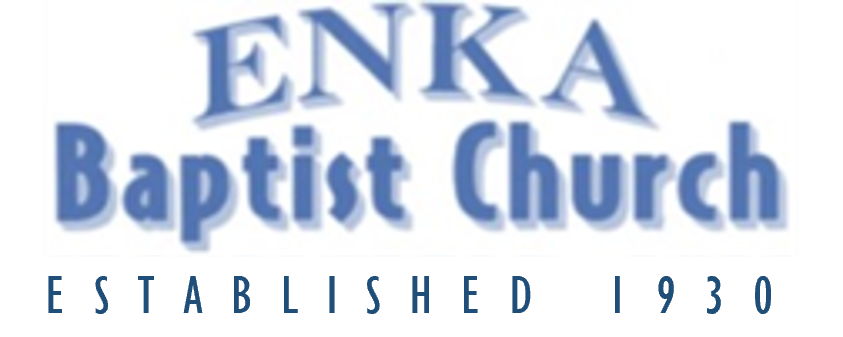
During the winter of 1929, Rev. John Carmine Bennett, Sr., then pastor of Hominy Baptist Church in Candler, North Carolina, had a vision for those families living in the Enka Village. He acted on that vision by visiting each house in the village and finding several Baptists who did not have a local church affiliation because they had moved into the community to work for American Enka Corporation.
After Rev. Bennett’s work—holding meetings in homes, detailing needs, and listing objectives and responsibilities in church organization—a small group of Baptists were willing to accept the challenge and make the sacrifices necessary to organize a church within their community. After several monetary commitments and contributions were made, American Enka Corporation agreed to give the land and furnish the labor for construction if the Baptist State Board would supply building materials. Hominy Baptist believed in what their pastor was doing, and supported him by allowing him ample time and full authority to complete the organization.
The first building was a small frame structure made of wood which, because of free labor, cost $1,000. It contained a sanctuary and three rooms, with curtains separating Sunday School classes as necessary. Rev. Bennett agreed to serve as part-time pastor, and he served until his sudden death on December 6, 1931.
On March 23, 1930, an original group of thirteen individuals met in the unfinished sanctuary of this first building. Through their work with the Associational Baptist Council (Buncombe Baptist Association), they became a member, and the new body was christened Enka Baptist Church. Because of holding the Charter open for approximately four more months to permit additions, by July 13, 1930, the number increased to forty-one.
After the sudden death of Rev. J. C. Bennett it became necessary to come up with a way to support a new pastor. Through faith and wisdom the matter was resolved: 27 members signed a petition pledging $29.00 per month to apply on a full-time pastor’s salary. Rev. J. W. Roberts was then called as pastor.
Other important dates in the history of Enka Baptist:
1. August 21, 1939 – Groundbreaking for new building.
2. September 28, 1941 – First service held in new building.
3. October 25, 1964 – New Educational Building dedicated.
4. September 28, 1977 – Contract negotiated for installation of stained glass window, which was designed by Robert R. Barnes.
The Rooster Weather Vane atop the Bell Tower of Enka Baptist Church
Mr. Jan Heykoop, Director of the Building Department at American Enka Corporation, contributed materials, and Mr. James Wilde, a member of Enka Baptist Church and employee in the Instrument Shop, constructed the rooster weather vane. It was designed by Mr. Clyde W. Rice, Architect at the American Enka Corporation.
This weather vane is an active protector from lightning for the buildings, having a solid No. 4 copper conductor running down to a grounding electrode in the basement.
Brief History of the Weather Vane
In Greece, and later in other locations, the weather vane was designed and used to forecast the weather before the barometer was invented. An east wind indicated rain, a south wind brought warm weather, the north wind was for cold weather, and the west wind was most gentle and best. In New England, maple syrup ran best when the wind came from the west.
In the ninth century, Pope Nicholas I decreed that the symbol of a rooster (or cock) be installed at the top of every church in Catholic Christendom. The rooster was to remind the worshipers of Peter’s betrayal of Christ, and to summon them to come to services and not deny Christ. This edict is no longer observed.

The Stained Glass Window at Enka Baptist Church

This synopsis is from the article written by Robert R. Barnes on the history of our stained glass window. The Committee was made up of Frank Crawford, Ellen Payne and Robert R. Barnes, and was approved on August 3, 1977.
The head of Christ is a mixture of four paintings by the Old Masters. The eyes and upper nose from one painting, the lower nostrils and mouth from another, the beard and chin from a third, and the forehead and hair from a fourth.
Christ’s stature of rank and royal authority is represented by the purple robe; the red garment close to his breaking heart represents the bleeding, suffering and dying for the sins of the world.
The encircled diving dove overhead indicates the Spirit of God descending as a dove, which occurred following Christ’s baptism. His open arms beckon all races and peoples to come unto Him. In the border around the window we see the purity of white, royalty of the blue and stability of the gold, which cements God’s complete plan of salvation in Jesus Christ.
The window inspired the writing of the following poem by Emma Mashburn:
His Eyes
I look at our stained glass window
With Jesus standing there,
And His eyes, so loving and tender,
Seem to follow me everywhere.
If I am sad they lift me up
Saying, “I am always near.”
When I am afraid they comfort me,
Telling me not to fear.
When I have sinned they touch my soul,
Those eyes that turned Peter’s way;
And I know, like Peter, that I have been warned
To be careful not to stray!
I am always reminded that Jesus still lives,
That He has the power to save.
For because He died and rose again
We can rise victorious over the grave!
